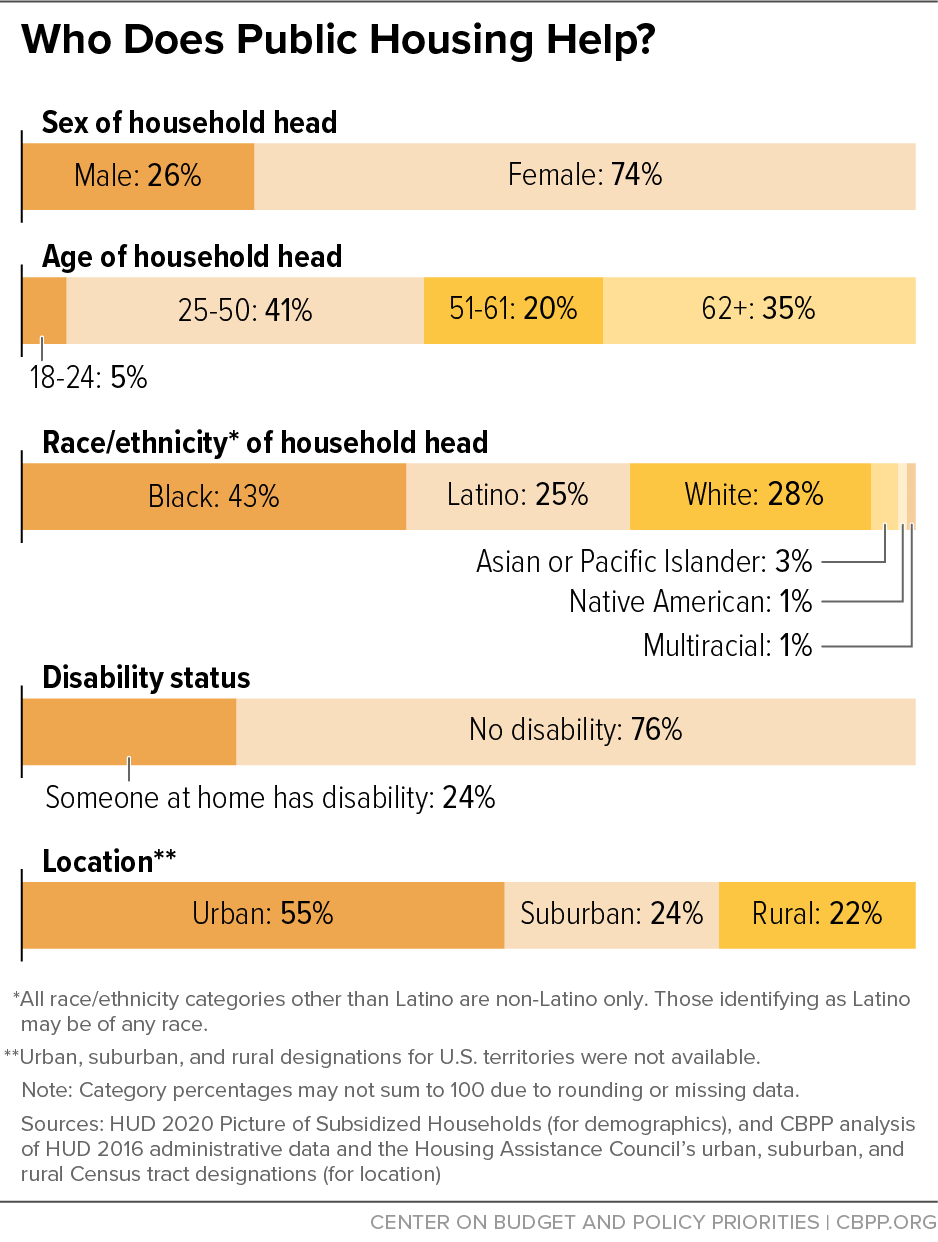Policy Brief: An Agenda for the Future of Public Housing
The nation’s public housing is a vital source of stable, affordable homes for more than 900,000 low-income households, of which a large majority have incomes below the poverty line and more than 70 percent are headed by a person of color. Public housing can deliver major benefits to the people it serves, not only helping them keep a roof over their heads but also potentially acting as a platform for services that improve other aspects of their lives and contributing to reinvestment and improved conditions in surrounding neighborhoods. But much of the nation’s public housing stock requires a new set of policy approaches to realize this potential, including large increases in federal funding. Without these changes, living conditions — already unsafe and unhealthy in too many properties — will likely worsen and more developments will deteriorate to the point where residents are forced to move.[2]
There has long been a pressing need to reinvest in public housing so it can better serve its residents, but recent events have made the urgency of doing so more apparent. The pandemic and economic downturn highlight the importance of providing safe, stable homes for the lowest-income people (who are disproportionately likely to have health conditions that make them vulnerable to COVID-19) and of preserving and adequately funding developments like public housing that play that role. In addition, the heightened attention on racial injustice underscores the close link between the challenges facing public housing today and a long history in which governmental policies segregated many public housing developments and the surrounding neighborhoods, and then denied those developments and neighborhoods needed resources. Lastly, the accelerating pace of climate change makes it more imperative that policymakers promptly invest in the energy efficiency of public housing and protect or relocate developments that are exposed to rising flood risk.
Reflecting input gathered through a series of convenings in 2019 and 2020 among public housing agencies, residents, and other stakeholders and experts,[3] we’ve compiled an agenda of nine sets of federal policy proposals to address the challenges facing the current public housing stock. These fit into three categories, which could be broadly characterized as focusing on buildings, neighborhoods, and people (all intended to better serve current and future residents). The first set of proposals (1-4 in the list below) would provide resources and other support to renovate public housing buildings and maintain them going forward. The second set (5-7) would aim to address the history of segregation and disinvestment in the neighborhoods where public housing is located by improving conditions in those neighborhoods and broadening options for public housing residents and other low-income people to live in a location they choose. Finally, the third set of proposals (8 and 9) would strengthen supports for residents and make public housing more inclusive.
- Upfront renovation funding. Provide $70 billion (or as much of that amount as possible) in public housing capital funds through an infrastructure package or other legislation to address unmet renovation needs in public housing.
- Adequate ongoing public housing funding. Increase ongoing subsidies through the public housing operating and capital funds to ensure that local public housing agencies consistently have sufficient funds to operate, maintain, and repair developments that remain in the traditional public housing program.
- Improved Section 8 conversion option. Improve the Department of Housing and Urban Development’s Rental Assistance Demonstration (RAD) — which gives agencies the option to convert public housing developments to long-term project-based Section 8 assistance — to provide higher subsidies and stronger protections for long-term affordability and resident rights. (Or alternatively, create a new conversion program that incorporates those improvements.) Limit removal of public housing through options (such as “demolition and disposition”) that don’t provide those protections.
- Making policies work at small housing agencies. Ensure that funding and policy changes work for families and communities served by small agencies, by providing stronger technical assistance, oversight, and support for coordination among agencies.
- Investment in public housing neighborhoods. As part of a broader effort to improve conditions in neighborhoods that surround public housing, evaluate the impact of Choice Neighborhoods Initiative (CNI) revitalization grants for distressed housing developments, improve resident protections under the initiative, and moderately raise CNI funding (with larger increases contingent on evaluation results).
- Expanded housing choice for residents. Give public housing residents broader choice about where they live through improved implementation of the RAD choice-mobility option and other measures.
- Using replacement public housing units to address historical inequities. Make it easier to replace public housing units that were lost in the past (those beneath the “Faircloth limit”) by allowing replacement units to receive long-term project-based Section 8 subsidies. Use replacement to address historical inequities in the location of public housing.
- Improved services for residents. Develop and fund a new model to make services broadly available to public housing residents and other rental assistance recipients.
- Fairer access to public housing. Develop a new framework for providing access to public housing for people who have struggled with substance use or have been involved with the legal system, such as people who have been arrested, incarcerated, or convicted.
These proposals focus on the existing public housing program — specifically on preserving, improving, and replacing public housing that is in place today or was lost in the past. Due to inadequate funding, public housing and other federal rental assistance reaches only a small fraction of people who struggle to afford housing. New publicly owned or controlled affordable housing can help address the pressing unmet need for rental assistance, as part of a multipronged strategy that should also include a large expansion of the Housing Choice Voucher program and other measures. But as policymakers consider that broader challenge, they must not lose sight of the urgent challenges facing the existing public housing stock and the more than 1.8 million people who call it home. (See Figure 1.)
Federal Policy Changes Can Help More Families with Housing Vouchers Live in Higher-Opportunity Areas
End Notes
[1] This paper benefitted from data analysis and research assistance by Erik Gartland, Alicia Mazzara, and Madeline Youngren, from input and feedback by Susan Popkin, Diane Levy, and other staff at the Urban Institute, and the insights of participants in the Future of Public Housing convenings.
[2] The full version of this report is at https://www.cbpp.org/research/housing/an-agenda-for-the-future-of-public-housing.
[3] The Center on Budget and Policy Priorities and the Urban Institute launched the Future of Public Housing initiative to develop a federal policy agenda to address the challenges facing the current public housing stock. In 2019 and 2020, we co-hosted convenings of public housing agencies, residents, and other stakeholders and experts to discuss this topic. Those convenings demonstrated consensus around the urgency of preserving public housing as a source of affordable homes for the lowest-income people and improving its effectiveness in serving residents. They also identified a set of ideas for achieving those goals, many with broad stakeholder support. For more, see Susan J. Popkin et al., “The Future of Public Housing: Confronting the Challenges Facing the Public Housing Program,” Urban Institute, May 2020, https://www.urban.org/research/publication/future-public-housing-confronting-challenges-facing-public-housing-program.
More from the Authors



